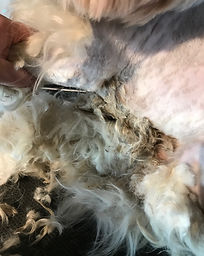

.....the coat rolls off like stockings!

..... coat takes the form of a sheep's fleece!

.....dirt and debris caught in the coat!
The Hazards of Dematting -Always Humanity over Vanity!
Firstly, we are not here to judge you! There is no doubt that some coat types are extremely high maintenance and when taking into account the UK weather, lifestyles, time available, and the willingness of your dog to be groomed, it doesn't take long for your dog's coat to become unruly! We are here to help you and your dog take back control!
Realistically, how much time do you have available to dedicate to the grooming of your dog?
Most breeds are chosen primarily for their looks, or for their lack of shedding. For example, Bichons, Poodles & Cockerpoos don't shed which is great for your lounge, however the coat continues to grow and remains on the dog! With our busy lives, it doesn't take long for minor knots to turn into major mats.
Risks of Dematting & Shaving
As careful as we are, when using sharp implements on a moving target, there are bound to be risks involved.
We use a variety of scissors and blades that help remove knots that cannot be combed out, but when the area is already sore, it is likely that the dog will resist. We have to exercise extreme caution as occasionally, the skin will be caught inside the knots. If the risk of injury is too high, we will always shave. This may be a decision to spot shave or to shave the coat completely.
When the decision has been made to shave, things become a little easier for both the dog and the groomer, but the risk of injury still exists. Clippers have to move under the matted areas, which means we occasionally have to use surgical blades. The skin can become quite irritated when shaved closely, and the risk of cutting the skin increases significantly, especially if the skin is caught inside.
Aside from the risks associated with scissors and blades, there are other risks associated with removing a matted coat.
Any pre-existing wounds and sores are now more visible, and your dog may lick and scratch at them, causing infections (if they aren't already infected). It is common for the skin to be irritated after being shaved. However, this should settle within a few hours.
Wounds should heal well following the groom as there will be improved cleanliness and airflow, but any areas that are already infected, slow to heal, are red, hot to the touch, or have an unpleasant odour or discharge should be checked by your Vet immediately.
Where a coat has been matted for a period of time, the skin will have been pulled, and in some cases, blood flow will have been restricted. Following a matted shave, the skin can be very red and possibly bruised, which in most cases, will return to normal within a few days. We move at a steady pace with the clipper to allow blood to refill the area slowly. However, no matter how careful we are, on rare occasions, blood can overfill the tissues causing haematomas to form. This is a common problem when a dog has severely matted ears. The dog will feel very different after the matted coat has been removed, which will cause him to shake his head, further exacerbating the problem. If this should happen, it is essential that you see your Vet as soon as possible!
Please note that we will not put a puppy or very nervous dog through a dematting process under any circumstances. Some knots are easy to remove, but where matting is extensive, it is neither humane nor practical to expect a dog to stand for extended periods of time in pain or discomfort. Shaving is not something we like to do; if your dog doesn't look good, then neither do we, but humanity has to come before vanity every time! We can put you back in control and provide advice on the best way to care for your dog's coat going forward.
In extreme cases, we may advise that the coat be removed by a Veterinary Surgeon under anaesthetic.








